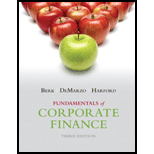
Concept explainers
Capital Structure: It refers to that structure which shows the combination of arranged funds from different sources of finance such as equity and debt.
Unlevered Capital: It refers to that type of capital of the firm which does not include any types of debts. Therefore, it does not involve any interest liability.
Leverage: It is a kind of strategy to maximize the amount of return available for the various investors of the firm, which also increase the value of the firm. The firm with the combination of debt and equity in its capital structure is known as levered firm.
a.
To determine:
The expected
b.
To determine:
The expected return on equity of the firm when debt-equity ratio is 1.50.
c.
To determine:
The capital structure that leads to the highest expected return for the stock.
Want to see the full answer?
Check out a sample textbook solution
Chapter 16 Solutions
Fundamentals of Corporate Finance (3rd Edition) (Pearson Series in Finance)
 Essentials Of InvestmentsFinanceISBN:9781260013924Author:Bodie, Zvi, Kane, Alex, MARCUS, Alan J.Publisher:Mcgraw-hill Education,
Essentials Of InvestmentsFinanceISBN:9781260013924Author:Bodie, Zvi, Kane, Alex, MARCUS, Alan J.Publisher:Mcgraw-hill Education,

 Foundations Of FinanceFinanceISBN:9780134897264Author:KEOWN, Arthur J., Martin, John D., PETTY, J. WilliamPublisher:Pearson,
Foundations Of FinanceFinanceISBN:9780134897264Author:KEOWN, Arthur J., Martin, John D., PETTY, J. WilliamPublisher:Pearson, Fundamentals of Financial Management (MindTap Cou...FinanceISBN:9781337395250Author:Eugene F. Brigham, Joel F. HoustonPublisher:Cengage Learning
Fundamentals of Financial Management (MindTap Cou...FinanceISBN:9781337395250Author:Eugene F. Brigham, Joel F. HoustonPublisher:Cengage Learning Corporate Finance (The Mcgraw-hill/Irwin Series i...FinanceISBN:9780077861759Author:Stephen A. Ross Franco Modigliani Professor of Financial Economics Professor, Randolph W Westerfield Robert R. Dockson Deans Chair in Bus. Admin., Jeffrey Jaffe, Bradford D Jordan ProfessorPublisher:McGraw-Hill Education
Corporate Finance (The Mcgraw-hill/Irwin Series i...FinanceISBN:9780077861759Author:Stephen A. Ross Franco Modigliani Professor of Financial Economics Professor, Randolph W Westerfield Robert R. Dockson Deans Chair in Bus. Admin., Jeffrey Jaffe, Bradford D Jordan ProfessorPublisher:McGraw-Hill Education





